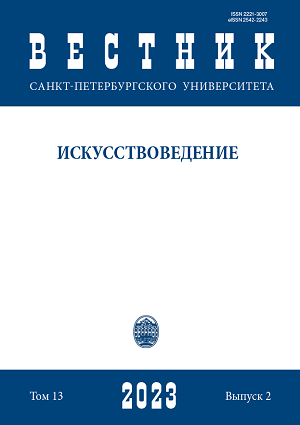‘Artistic Text’ in the Artworks of V.E.Makovsky: Rhetorical Figures and Visual Tropes
DOI:
https://doi.org/10.21638/spbu15.2023.203Abstract
The article is devoted to the study of visual semantics in the artworks of the famous artist Vladimir Makovsky (1846–1920). This painter entered the history of Russian art as an outstanding master of “small genre”, the author of a short, fascinating story in painting. It is no coincidence that the contemporaries compared the characters in V. Makovsky’s paintings with the heroes of N. Gogol’s, I. Turgenev’s, A. Ostrovsky’s, L. Tolstoy’s, M. Gorky’s, A. Chekhov’s works. The author makes an attempt of interdisciplinary research, analyzing the “Artistic text” in V.Makovsky’s paintings in the aspect of philological problems, using the appropriate methodology and terminology, as well as touching upon the issues of psychological perception and comprehension of his works of art. The article draws parallels between the rhetorical figures (antithesis, comparison, metaphor, metonymy, hyperbole) and the visual tropes in V.Makovsky’s paintings and, using specific examples, examines the role of the psychological landscape, quotation, artistic detail, mirror, observer’s position, the techniques of “story in a story” (“picture in a picture”) in painting. Language — a cultural code — performs two formally opposite functions: on the one hand, it preserves and reproduces traditions, and on the other, it provides dynamics through creative innovation. Verbal language affects the viewer gradually in time, with a clear sequence of language elements, visual language affects the viewer one-step and complex. It is argued that in V. Makovsky’s artworks there is an intense penetration of techniques and image-associative references associated with literary tradition. The means of artistic expression in literature and in visual arts reflect the action of general mental operators associated with creation and transformation activities.
Keywords:
V. E. Makovsky, Peredvizhniki, rhetorical figures, visual tropes, titles of artworks, word and image, dialogues between the verbal and the visual, Russian art
Downloads
References
Downloads
Published
How to Cite
Issue
Section
License
Articles of "Vestnik of Saint Petersburg University. Arts" are open access distributed under the terms of the License Agreement with Saint Petersburg State University, which permits to the authors unrestricted distribution and self-archiving free of charge.






